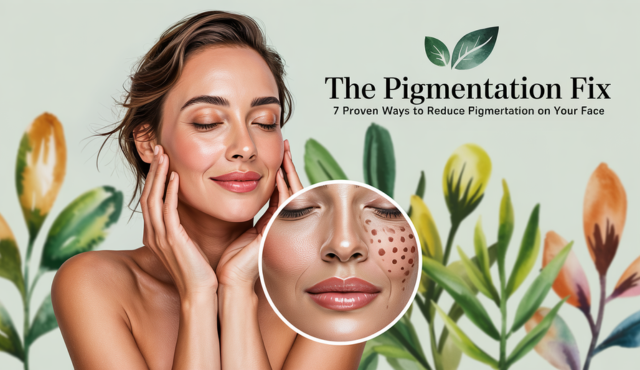
Ever looked in the mirror and wondered where those dark spots or uneven patches on your face suddenly came from? You’re not alone. In India, nearly 40% of dermatology visits are related to pigmentation issues—especially melasma, sun spots, and acne scars. Blame it on our tropical climate, rising pollution levels, or simply stress—pigmentation is more common than most of us realise.
But here’s the good news: you can fix it. And no, we’re not talking about 10-step routines or pricey miracle creams that overpromise and underdeliver.
“The Pigmentation Fix: 7 Proven Ways to Reduce Pigmentation on Your Face” is your local-friendly guide to achieving clear, even-toned skin—without the overwhelm. Backed by real science and tested by dermatologists across India, we’ll walk you through simple, effective treatments—from kitchen-friendly ingredients like turmeric and aloe vera to modern options like chemical peels and niacinamide serums that actually work.
Let’s cut the fluff and get to the fixes—because glowing skin shouldn’t be complicated.
Why is treating pigmentation important for skincare?
Treating pigmentation is essential for maintaining healthy, even-toned, and radiant skin. Pigmentation—whether caused by sun damage, hormonal changes, or acne scars—can make your skin appear dull, patchy, and older than it really is. When left untreated, these dark spots may deepen over time on your skin which can make them harder to fade which actually affecting your overall confidence.
More importantly, pigmentation is often a sign of underlying skin damage. By addressing it early, you’re not just improving your skin’s appearance but also preventing further issues like inflammation, uneven texture, and premature aging.
In a country like India, where high UV exposure is a daily reality, so protecting and treating your skin becomes even more crucial. Regular care helps strengthen your skin barrier, improves brightness, and allows skincare products to work more effectively. Simply put, treating pigmentation isn’t just about beauty—it’s a key step toward healthier, more resilient skin in the long run.
How to Reduce Pigmentation on Face – 7 Steps
Pigmentation on the face can be stubborn, but with the right approach, it’s actually possible to fade dark spots. Here are 7 effective steps to reduce pigmentation safely and naturally:
1. Use Broad-Spectrum Sunscreen Every Day
UV rays are one of the biggest triggers for pigmentation. Whether it’s sunny or cloudy, apply a broad-spectrum sunscreen with SPF 30 or higher every morning. In India’s climate, reapplying every 3–4 hours is crucial if you’re outdoors. This one habit alone can prevent existing spots from darkening and stop new ones from forming.
2. Start with a Gentle Skincare Routine
Harsh products can irritate the skin and worsen pigmentation. Use a mild, pH-balanced cleanser and avoid scrubbing too hard. Choose fragrance-free, alcohol-free moisturisers that hydrate your skin without causing sensitivity or inflammation.
3. Add Targeted Serums to Your Regimen
Look for serums with ingredients like niacinamide, vitamin C, kojic acid, alpha arbutin, or licorice extract—these work at the cellular level to fade pigmentation and brighten the skin. Apply them after cleansing, before moisturiser.
4. Try Natural Remedies Backed by Science
Home remedies like aloe vera gel, green tea extract, turmeric (curcumin), and sandalwood have shown anti-pigmentation effects in studies. These natural options can be soothing and effective when used consistently and correctly.
5. Exfoliate Smartly (But Not Too Much)
Exfoliating helps remove dead skin cells and allows brightening ingredients to absorb better. Use gentle exfoliants like lactic acid or mandelic acid 1–2 times a week. Avoid overdoing it, as excessive exfoliation can lead to inflammation and worsen pigmentation.
6. Consider Dermatological Treatments
For deep or persistent pigmentation, consult a dermatologist. Treatments like chemical peels, laser therapy, or microdermabrasion can deliver faster results. These are safe when done under professional supervision and are increasingly popular across India.
7. Be Consistent and Patient
Pigmentation doesn’t disappear overnight. Stick to your routine for at least 8–12 weeks to start seeing noticeable improvement. Avoid switching products too often and give your skin the time it needs to heal and renew.
By combining daily sun protection, smart skincare, and a little patience, you can reduce pigmentation and restore your skin’s natural glow—one step at a time.
Conclusion:
Pigmentation may be common, but it doesn’t have to be permanent. By following these 7 proven steps—from daily sun protection to smart skincare and advanced dermatological options—you can visibly reduce pigmentation and achieve clearer, more even-toned skin. The key lies in consistency, patience, and choosing products that truly work for your skin type.
If you’re a skincare business or beauty brand looking to create effective, pigmentation-fighting formulations, RevieraOverseas can help. As one of India’s leading private label skincare manufacturers, we offer custom solutions backed by science and tailored for visible results.
Whether you’re starting your skincare brand or expanding your product line, partner with Reviera Overseas to bring innovative, high-quality pigmentation care products to the market.
Remember, great skin isn’t just about looking good—it’s about feeling confident in your own skin, every day. Start your journey toward brighter skin and a brighter brand today.